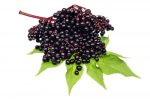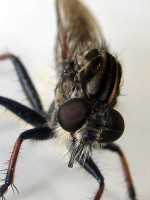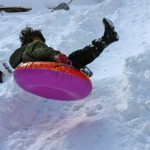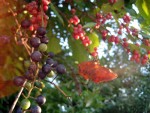I ran across a blog this week that was hosting a giveaway for Zippity Doo’s- Children’s Daily Use Hair Care Products that Help Prevent Lice!
OK, I’m not even going to mention the seemingly unnecessary apostrophe in the product name, as that is just me being nit-picky (hee!). I’m also not going to discuss the notion that buying a shampoo specifically for lice prevention feels ridiculously alarmist. Nope, totally going to let those points go.
But I wondered what the heck was in these hair products that could prevent lice. After all, moms spend the big bucks on shampoos that are tear-free, fragrance-free, super gentle. Were they seriously trying to sell us a low-grade pesticide to use on our kids’ hair?
Well, no, not really. The product page for the shampoo reads as follows:
Ingredients
Zippity Doo’s™ Shampoo for Children was created to help repel lice and other insects from the hair. Made with a special combination of natural ingredients, including Vitamin D, Carrot Seed Oil, Alpha Hydroxy, Rosemary, Cinnamon, Tea Tree, Anise & Lavender designed to promote healthy hair & scalp while repelling lice & other insects.
That sounds good, right? Made with a special combination of natural ingredients. And, oh look, check out how transparent they are, they’re got a photo of the actual ingredients list that you can click on. Looks like this:
Awesome. So I click on that.
Now, if you want to actually READ the ingredients, you have to turn your computer on its side:
and then write the ingredients down, no easy cut-and-paste job here. Which I do ’cause I’m crazy like that.
We can really look at the ingredients in order now, and I hope that every mom considering this product takes the time to do just that.
Water (Aqua). I have no issues here, other than paying $10.99 to $12.99 for a product that is mostly water makes me stabby.
Sodium Laureth Sulfate (SLES): This set off some alarm bells. A quick search turned up that SLES can be contaminated with 1,4-dioxane which is considered to be a probable carcinogen. Although apparently not as bad as its kissing cousin, Sodium Lauryl Sulfate, SLES can’t be metabolised by the liver; therefore it residually stays in your system longer and contributes longterm to your toxic “body burden.” The Journal of The American College of Toxicology reported that concentrations as low as 0.5% could cause irritation and concentrations of 10-30% caused skin corrosion and severe irritation. Yummy!
Disodium Cocoamphodipropionate: seems to be an innocent enough liquid that contributes “a faint fruity odor.” Which is fine, I guess, if you like your kids smelling fruity (why do most kids’ shampoos smell like overripe fruit, by the way? Does this seem strange to anyone else?)
Cocamidopropyl Betaine: Because it is derived from coconut, cocamidopropyl betaine seems to be touted as the natural alternative to SLES (although that’s not the case with this product, as it has BOTH). My friend Google reveals: According to a study done by the Environmental Working Group in 2006, roughly 10% of all products containing cocamidopropyl betaine contained harmful traces of carcinogenic nitrosamines. In addition, cocamidopropyl betaine is a known skin, eye, and lung irritant.
Lauramide DEA: Google says… The Federal National Toxicology Program (NTP) completed a study in 1998 that found an association between the topical application of diethanolamine and certain DEA-related ingredients and cancer in laboratory animals. For the DEA-related ingredients, the NTP study suggested that the carcinogenic response was linked to possible residual levels of DEA…The presence of DEA in cosmetics, including shampoos, can also lead to formation of nitrosamines, which are powerful carcinogens. Many nitrosamines have been determined to cause cancer in laboratory animals and have also been linked with human cancer. These have also been shown to penetrate the skin.
People, these are the top five ingredients, and therefore the most prevalent. “Special combination of natural ingredients,” my Aunt Tilly.
Now, I’m no chemist or doctor, and I can’t speak to whether these chemicals are really toxic or carcinogenic, whether they permeate the skin or have residual effects. But to package these products for children as a safe preventative for lice, as natural? To list the ingredients on the product page as cinnamon and rosemary and whatnot when 3 of 5 of the most prevalent ingredients are unpronounceable and questionable?
I have serious issues with that.
I seem to be the only one, though… The giveaway post where I found this product had over 70 entries from moms who seemed to think that this is an awesome idea.
It also said that the key ingredient to keeping lice away was the pure rosemary oil. So, if you’re really committed to the idea of preventative lice treatment, maybe consider adding a few drops of organic rosemary oil to a safer kids’ shampoo. And teach them not to share hats, brushes or hair clips with other kids.
What do you think? Am I being overly critical here?
Do you read the labels on your hair care products? Are you so concerned about lice that you would buy this product? Let me know, I’m intensely curious.














One thing that you have to remember, when a study says that it causes cancer in lab rats, you need to see what was the dosing schedule. Usually it is hundreds if not thousands of times more then we would be exposed to in a consumer product. Anything in excess can make us sick or kill us.
Just a thought.
Amen, sistah! I hate when products call themselves "natural" when they really aren't. I admit that not ALL of the products I buy are "green," but I do so knowingly. I try to buy safe products as often as possible, though; and when I do, I expect them to be just that. I hope you didn't find that giveaway on a green blog. YIKES!
BTW ~ Great rant! Very enjoyable read!
YES I READ LABELS ALL THE TIME! INGREDENT NUMBER 4 , I FOUND OUT I AM ALLERGIEC TO. WHEN I WAS ABOUT 20 I BROKE OUT IN A RASH THAT GOT WORSE AND WORSE AS TIME WENT ON. I LOOK TO MY BEAUTY PRODUCTS THINKING IT WAS SOMETHING I WAS USING BEING AS IT WOULDNT GO AWAY. THAT WAS THE COMMON INGREDIENT IN ALL OF MY BEAUTY PRODUCTS. I DON'T KNOW WHY BUT IT STOOD OUT. SO I SEARCHED FOR PRODUCTS WITHOUT IT( NOT EASY). SURE ENOUGH WHEN I STOPPED USING IT IN TIME THE RASH WENT AWAY. SO I AM VERY CAREFUL ABOUT WHAT I USE AND ALSO MY CHILDREN. IT IS HARD TO FIND PRODUCTS WITHOUT IT. THAT SEEMS REALLY WRONG A SHAMPOO THAT HELPS PREVENT LICE, WHAT!
@Anonymous: True enough; anything in excess is a health risk. What bothers me is that we don't know the long term effects of these chemicals, how they build up over time in our systems, or how they interact with each other over time. And, of course, the illusion of "natural" ingredients.
@Beverly: Thanks, glad you enjoyed it 🙂 I do hope that people don't buy "natural" products just because the label says so. I'm not 100% green either but I try.
@kat: My son is very sensitive to shampoos and soaps, you're right- it's hard to find products without these ingredients. I think #4 is used for the lather; we're so brainwashed into thinking we need the bubbles to get clean!
Thanks for visiting and commenting, everybody!
It is imperative to read the labels and know what your children are allergic to. It gives one a knowledge and not wasting money on certain item that isn’t fit for use to your children.